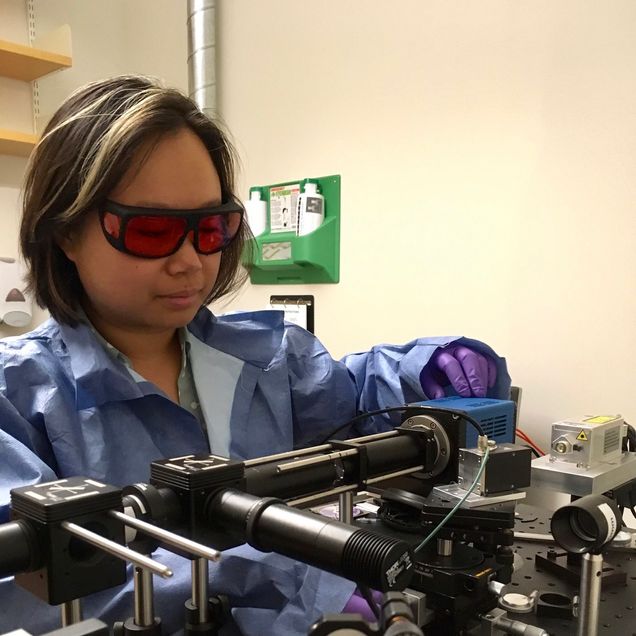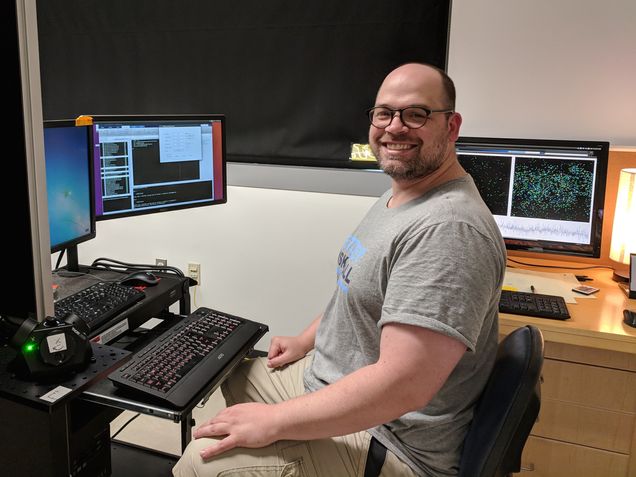Training the Next Generation of Neurophotonics Researchers

With a background in electrical engineering, Jenny Sun had little experience with neurophotonics—with neuroscience, generally—when she entered the “Understanding the Brain: Neurophotonics” training program at Boston University just about a year ago. Now, Sun, a second-year graduate student at BU, is designing and building an advanced ultrafast wide-field microscope for imaging of neurons in mouse models.
Sun’s story might seem an anomaly, something of a quirk in a world where, historically, researchers are highly specialized and seldom cross over into other fields. In fact, bridging disciplines like this is one of the major goals of the program. “I hadn’t been exposed to a lot of biology before I signed up but I had always been fascinated by how the brain works,” Sun says. “With this program, I saw an interesting opportunity to learn more about the brain, and to explore the intersection of neuroscience and what I was already studying.”
Launched just two years ago, the National Science Foundation (NSF)-funded research traineeship program—better known at BU as the NRT program—brings together Ph.D. students in biology, neuroscience, biophysics, and engineering who are interested in using photonics to explore the role of the brain in a variety of human activities. The mandate of the program is to train students to adopt a broader perspective and work with collaborators from across the research spectrum to achieve their many goals.
“The idea was to create a program where students from different backgrounds are immersed in and thrive in an interdisciplinary environment,” says Helen Fawcett, program coordinator with the NRT who also played an integral role in developing the program. “Photonics is the enabler; we are using light to group all of these students together.”
A second, complementary goal is to support women and underrepresented minorities seeking training in interdisciplinary studies. The program’s target enrollment is 40 percent women and 20 percent underrepresented minorities; a total of 20 students receive fellowships.

Preparing students for a career in research
The five-year NRT program provides unparalleled opportunities to explore neurophotonics and work with some of the most accomplished researchers in the field. Trainees take part in immersive hands-on training and lab rotations with world-class faculty, interdisciplinary coursework and research for their Ph.D. dissertation, and professional development mentoring. They can also learn from the many neurophotonics events and additional training opportunities held throughout the year. Among these are seminars, an annual symposium, summer school workshops and more.
Students’ tenure in the program officially begins with the aptly named Boot Camp. Over the course of three days each July the newest NRT cohort assembles for a series of crash courses in the fundamentals—neurophotonics and neuroscience more broadly—as well overviews of select topics in relevant areas of inquiry. The latter have included core courses in microscopy, fluorescent markers and optogenetics. Boot camp is designed to bring trainees up to speed, so they begin with a baseline understanding of the material. This is integral to the success of the NRT. Thus far, 63 percent of new trainees have not had photonics training prior to entering the program; 31 percent have not had any neuroscience training at all.
The NRT Boot Camp also includes a modified version of the Alan Alda Communicating Science training program, which helps researchers improve their communication skills so they can better explain their work to family and friends as well as to colleagues. An ability to communicate the esoteric and complicated concepts explored in the NRT program is especially important because neurophotonics is such an interdisciplinary field; trainees will need to break down what they are doing so collaborators, for example, can easily understand it. It can also help with team building and community development within the program, Fawcett says, by facilitating robust interactions among the trainees.
This focus on communication is woven throughout the entire program, and indeed throughout the sciences at the university. BU is one of 17 schools chosen by the National Institutes of Health (NIH) to participate in its Broadening Experience in Scientific Training (BEST) program, which offers professional development curricula designed to help Ph.D. students and postdoctoral trainees explore career paths in the biomedical sciences both inside and outside academia. These curricula include the full-blown version of the Alan Alda Communicating Science program. So not only is the focus on communication embedded in the culture of the sciences at the university, instructors trained by the Alan Alda program are on staff and available to work with the NRT.
Revealing new opportunities
Students enrolled in the NRT are already seeing the benefits of the interdisciplinary program and the broader perspective it provides. Scott Knudstrup was introduced to the NRT during his first year in BU’s Graduate Program in Neuroscience, and though he was working with two-photon imaging in the lab of Jeff Gavornik he had “virtually no prior experience” working with microscopes. Now, he is wielding advanced photonics technology to image the primary visual cortex of mice in order to study how cortical populations change during learning.
“The program has opened up avenues that I hadn’t considered before with respect to my career,” he says. “My background was entirely in theoretical and/or computational studies, and NRT has enabled me to get more into experimental work by giving me the tools to work with and understand sophisticated instrumentation.”
And this, of course, is just one of the many benefits the program offers. Knudstrup points to the many opportunities it affords to meet and develop relationships with researchers from diverse backgrounds. “NRT facilitates connections between people that span many disciplines and are at very different stages in their careers,” he says. “It’s especially great to have access to the NRT talks because it gets everyone under the same roof. In addition to the great lecturers that span many topics, these events make the process of forging personal connections with people outside of your immediate lab or research area much easier than they would be otherwise.”

The Guiding Hand of the NRT
Helen Fawcett is the not-so-secret secret weapon of the NRT. A mechanical engineer by training, with a wealth of additional experience in putting together interdisciplinary programs, she was the perfect person to help design and develop the NRT program. After the grant was awarded, she stayed on as program coordinator, recruiting and guiding trainees in the NRT and working with the associated academic departments at BU to ensure that the program offers an enriching experience without adding to the trainees’ total time to degree.
Fawcett is delighted to be working with the Neurophotonics Center to provide the best possible training environment for the students. “The Neurophotonics Center is an exciting place to be and the NRT program has been an opportunity to include the students in a central and key role of developing the neurophotonics research community,” she says. “I have had the distinct pleasure of being able to develop this foundation for them, meet and engage with all of the students during recruitment and participation in the NRT program itself and welcome this coming year to guide the students into becoming more active drivers of the program.”
